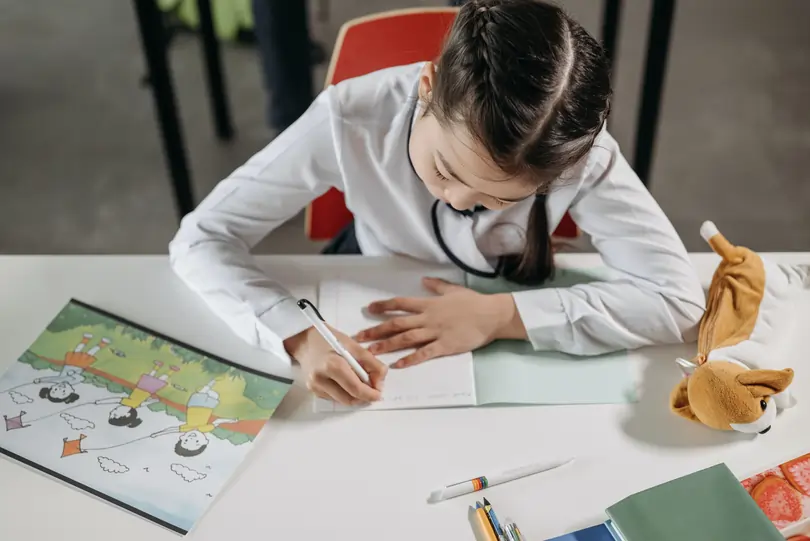Descriptive Writing Techniques

Often, you would have trouble finding the right words or descriptive expressions to use when describing your character. In this article, we will learn a technique that helps describe a developed character so that when you write, the readers are able to understand the character or imagine how they look.
Descriptive writing techniques primarily include two components, which are:
- Appearance
- Mannerisms
Describing Characters
Of the two primary components, let’s look at the physical aspect first.
- Physical Appearance
How would you describe someone based on physical appearance or rather, what you see, not what they do? This can be further broken down or categorised into the following different parts:
| Physical Appearance | |
|---|---|
| Expressions |
|
| Features |
|
| Hair |
|
| Physique |
|
| Outfit |
|
| Complexion |
|
Question 1:
The __________ teenager was the tallest in his class. At home, his mum was always telling him to eat more.
- lanky
- squat
- pudgy
- beefy
Answer:
The correct answer to this question is option 1 - lanky. “Lanky” is someone who is skinny and tall. The clue in the question is that he is the tallest in his class, and secondly, his mum always used to tell him to eat more, which means he is also skinny.
Question 2:
Describe this expression.

Image Credit: unsplash - Nathan Dumlao
- troubled
- furious
- calm
Answer:
To describe this expression, we would use option (1) - troubled. Furious would be incorrect here. The correct word to be used here is troubled, as he looks like he is at a loss of what to do and seems distressed.
Question 3:
The fearsome creature growled. I could see its sharp, __________ teeth in the dark.
- gleaming
- shimmery
- glowing
- dull
Answer:
“Gleaming” is always used to describe things that are shiny, for instance: a gleaming knife, the gleam of a gun etc. Another example of how “gleaming” is used:
There was an evil gleam in his eyes.
Gleaming is not necessarily a bad word and is not always associated with negative things although there is very frequently that connotation, Hence the correct answer to this question is option (1) - gleaming.
- Mannerism
Now we will now move on to mannerisms. You can describe a character’s attitude, emotions, state of mind, intentions etc by their body language. In order to build a realistic and engaging character, their descriptions of their mannerisms must be thoughtfully crafted so as to show what they’re doing and thinking, reacting and/or planning. Mannerisms can be further broken down or categorised into the following:
| Mannerisms | |
|---|---|
| Walking |
|
| Looking |
|
| Saying |
|
| Gestures |
|
| Adverbs of Manner |
|
| Emotions |
|
Question 4:
“I shall not spare your life,” said the queen __________.
- enthusiastically
- coldly
- timidly
- bravely
Answer:
The correct answer to this question is option (2) - coldly. “Coldly” means “in a way that is very unfeeling, hard or cruel. “Bravely” cannot be used here as the act of ordering someone’s death is not courageous. “Brave” is always used as a positive adjective and in a positive situation.
Question 5:
She’d finally had enough of the taunting. “STOP IT OR ELSE!” she __________.
- snapped
- whispered
- muttered
- advised
Answer:
The correct answer to this question is option (1) - snapped. This is a saying verb. Saying verbs are basically verbs that replace “said” in a sentence. A person snaps when they have been enduring hardship/struggles for a very long period of time in silence. Frequently, it simmers and finally reaches a boiling point, causing them to “snap”.
Question 6:
We __________ back to school after the tiring football match under the scorching sun.
- trudged
- scampered
- skipped
- glided
Answer:
The correct answer to this question is option (1) - trudged. To “trudge” is to walk in a slow, sluggish manner which is indicative of exhaustion.. “Trudge” is generally used to describe the way one walks after a long, gruelling day.
Test Your Concepts
Answer the following questions based on the concepts we’ve covered in this article. If you get stuck, revisit the relevant section to revise the concepts.
Question 1:
The teacher stared at Valerie’s __________ uniform. “Do you not have an iron at home?” she said sharply.
- crisp
- flawless
- amazing
- crumpled
Question 2:
Describe this facial expression.

Image Credit: pexels - Monstera Production
- Chirpy
- Grumpy
- Curious
Question 3:
The arrogant boy __________ around the school as if he owned it.
- strutted
- wandered
- darted
- slinked
Question 4:
He glanced around __________ before slipping into the empty classroom.
- soundly
- courageously
- warmly
- nervously
Question 5:
Maria __________ into the office, full of charm and confidence. “It’s going to be an easy day,” she thought.
- stormed
- dashed
- breezed


 SG
SG  VN
VN 















